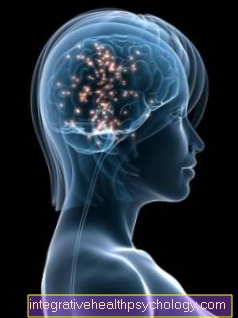Meningoencephalitis
definition
Meningoencephalitis is a combined inflammation of the brain (encephalitis) and its meninges (meningitis).
Meningoencephalitis partially combines the symptoms of the two inflammatory diseases and is triggered by various pathogens. Viruses are most commonly responsible for the disease. Especially people with weakened immune systems can develop severe meningoencephalitis. In some cases, serious consequential damage can remain.

Causes and causative agents of meningoencephalitis
Meningoencephalitis is usually caused by an infestation of the central brain or its meninges by a pathogen. Viruses make up the largest proportion.
Examples of viral pathogens are enteroviruses, the measles virus, the herpes simplex virus I (cause of cold sores), the Eppstein-Barr virus (cause of whistling glandular fever) and the flavivirus, which triggers the TBE, the early summer meningoencephalitis. The latter is transmitted through tick bites.
Bacteria usually cause isolated inflammation of the meninges. However, some strains can also attack the brain as part of this infection. The pathogens responsible for bacterial meningoencephalitis in most cases are called Listeria monocytogenes. Other representatives are the Staphylococcus aureus, Treponema pallidum (causative agent of syphilis) and Mycoplasma pneumoniae.
In rare cases and primarily in immunocompromised patients, meningoencephalitis due to fungi or other parasites can also occur. The Cryptococcus neoformans is a yeast that first affects the lungs and can then spread to the brain. Parasitic pathogens are Toxoplasma gondii (transmitted by cats), Plasmodium falciparum (which causes a form of malaria) and Trypanosoma.
You may also be interested in this article: Herpes simplex encephalitis
Symptoms of meningoencephalitis
Meningoencephalitis combines the symptoms of meningitis and encephalitis.
Meningitis is characterized by severe headache and neck pain, a high fever, nausea and vomiting and, in the advanced stages, a deterioration in consciousness (Somnolence, Drowsiness). If consciousness is very limited (Vigilance reduction), the examining doctor should interpret this as an indication of meningoencephalitis, since meningitis on its own is very rarely so severe.
Epileptic seizures can also occur as part of meningitis. Neck stiffness is a symptom that is easy to control diagnostically. If the examiner tries to lift the patient's head while it is lying flat, the affected person experiences severe pain and a defensive movement (the patient defends himself against the movement).
The symptoms of encephalitis are much less specific than those of the meninges. The inflammatory processes in the brain lead to so-called focus symptoms. Depending on which part of the brain there is inflammation, the corresponding functions fail.
Typical of encephalitis and also a possible symptom of meningoencephalitis can therefore be the change in character due to involvement of the anterior lobe. E.g. increased aggressiveness of the person concerned. Neurological changes such as speech and vision disorders can also occur depending on the location of the inflammation.
General symptoms can be a clouding of consciousness or headaches, but these originate from the meninges as the brain itself cannot feel pain. A dangerous symptom of meningoencephalitis is an increase in pressure in the brain, which can lead to life-threatening entrapment.
Read more on this topic at:
- Symptoms of meningitis
- Symptoms of encephalitis
Therapy of meningoencephalitis
In the treatment of meningoencephalitis, which is mostly caused by a virus, only a few drugs are available to the treating physician. Since there are only a few agents that work against viruses (antiviral), most viral infections have to be eaten out. Only symptomatic treatment is advisable.
In the case of herpetic meningoencephalitis, acyclovir, which is effective against the herpes simplex virus I, can be used. The administration of this antiviral drug may save the patient's life.
The possibilities of drug therapy are significantly better for bacterial meningoencephalitis. However, it must be ensured that the antibiotics also reach the brain. This is known as liquor accessibility (Liquor = nerve fluid surrounding the brain) and describes how well the drug reaches its target location from the blood across the blood-liquor barrier. Ceftriaxone has a high liquor penetration, which can be used universally for many different pathogens. If an infection with Listeria is assumed, an additional dose of ampicillin is necessary.
The treatment of fungal infections of the brain arises because of the poor fluid penetration of the antifungal agents (Antifungal drugs) difficult. Voriconazole has the greatest effect, but often needs to be combined with other antifungal agents to achieve adequate treatment.
The use of corticoids such as cortisone has a positive and a negative aspect. On the one hand, the long-term effects are reduced by less scarring of the inflamed tissue, on the other hand, the patient's immune system is impaired, which makes defense against the infection much more difficult and can prolong the healing process.
You might also be interested in this topic: Meningococcal vaccination
What sequelae can meningoencephalitis cause?
In the majority of all meningoencephalitis cases, consequential damage does not occur if treatment is given in good time.
In particular, the inflammation of the meninges influences the prognosis and is different depending on the pathogen. However, the most dangerous meningitis pathogens do not infect the brain, which is why confirmed bacterial meningoencephalitis often heals without consequences.
If the cause is viral, the prognosis also depends on the virus strain. For example, while an infection with measles heals in the vast majority of cases without any consequences for the patient, herpetic meningoencephalitis can cause severe damage.
The death rate of untreated cases of illness is 70% (treated cases 20%) and a quarter of the patients whose lives can be saved have severe consequential damage such as paralysis, intellectual disability or accompanying blindness due to retinal detachment.
What types of meningoencephalitis are there?
Herpetic meningoencephalitis
Herpetic meningoencephalitis is the inflammation of the brain caused by the herpes simplex virus I.
Around 90% of the population carries the herpes simplex virus I and many have already noticed it through a cold sore. If a person is infected with the virus, they will carry the pathogen for life. After the initial infection, the classic cold sore sometimes occurs (Herpes labiales). After the acute infection has healed, the virus settles in the nerve node of a facial nerve (trigeminal nerve) and can be reactivated if the immune system is weakened.
Herpetic meningoencephalitis occurs when the virus is reactivated and travels along the nerve fibers into the brain or when it re-enters the patient from outside. This happens through the nasal mucosa, through which it reaches the olfactory nerve (olfactory nerve). The olfactory nerve is a direct extension of the brain and allows the virus to infect the anterior and later the lateral lobes. The classic symptoms of meningoencephalitis occur. Speech disorders, olfactory disorders and (focal) epileptic seizures dominate as focus symptoms.
Read more on the subject below: Herpes simplex encephalitis
TBE
Early summer mengingoencephalitis (or TBE for short) is inflammation of the brain and its skins caused by a virus. This virus is mostly transmitted to humans by infected ticks.
Often the disease is totally asymptomatic. One third of the patients initially only experience flu-like symptoms such as headache, body aches and fever. It is typical for the course of the disease that these symptoms then improve. After a short period (2-3 days), however, there is a high fever with neurological symptoms such as impaired consciousness, seizures or paralysis. Then the patient needs intensive medical treatment.
However, there is no causal therapy against the virus. In most patients, however, the disease heals without serious consequential damage. However, there is always a risk of neurological sequelae remaining. Therefore, if you live in a corresponding risk area or go on vacation, it is best to get vaccinated against the TBE virus.
Also read our article: Vaccination against TBE
Granulomatous meningoencephalitis
Granulomatous meningoencephalitis is inflammation of the brain and meninges.
Granulomatous inflammation leads to the formation of small, nodular-like accumulations of cells (granulomas). These cell clusters mainly consist of cells from the immune system such as macrophages (phagocytes) or specialized white blood cells (monocytes).
Granulomatous meningoencephalitis usually affects the brain stem. These granulomatous foci of inflammation can be found along the blood vessels. The symptoms depend on the location of the disease in the brain. If the brain stem is affected, failures of the cranial nerves occur in particular.
You can also find out more at: Cranial nerves - you should know that!
Necrotizing mengingoencephalitis
Necrotizing mengingoencephalitis is inflammation of the brain and meninges.
In this form of inflammation, necroses develop very quickly in the center of the inflammation focus, i.e. the brain cells in the center of the inflammatory focus die. By destroying the brain tissue, the disease can only heal with scarring. One then speaks of defect healing. The clinical symptoms depend on the localization and the severity of the disease. Complete healing rarely occurs, and consequential damage often remains.
Primary amoebic meningoencephalitis
Primary amoebic meningoencephalitis is a rare and usually fatal disease. It is caused by an infection with amoeba.
Amoebas are single-cell organisms that do not have a fixed body shape, but can continuously change their body shape through the formation of pseudopods. They mostly live in stale fresh water. By bathing in contaminated water, the amoeba can get through the mucous membranes into the central nervous system and cause infection there.
The inflammation usually spreads quickly and can lead to death within 10 days.
also read: Amoeba
Cryptococcal meningoencephalitis
Cryptococcal meningoencephalitis is an infection with an encapsulated fungus, the Cryptococcus neoformans.
This usually occurs in patients with an immune deficiency e.g. as part of an AIDS disease. The fungus is mostly ingested by inhaling contaminated dust through the airways. Therefore, the lungs are usually colonized first.
If the immune system is weakened, the fungus can also spread to other organs, including the central nervous system. The inflammation of the brain and its skins usually develops slowly. The disease can be treated with special anti-fungal medications such as amphotericin B and fluconazole.
Listeria meningoencephalitis
Listeria meningoencephalitis causes inflammation of the brain and meninges caused by listeria. Listeria are gram-positive bacteria.
Mostly you get infected through contaminated food (especially raw milk products). However, patients with healthy immune systems can usually fight off the bacteria. Infection rarely occurs.
It is different with immunocompromised patients, pregnant women or newborns. These groups are at higher risk of developing meningoencephalitis from listeria. Antibiotic therapy is possible. However, patients at risk should avoid foods containing Listeria.
You might also be interested in: Diet in Pregnancy
Recommendations from the editorial team
- Encephalitis
- meningitis
- TBE
- Vaccination against TBE
- Meningococcal vaccination





























